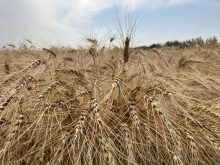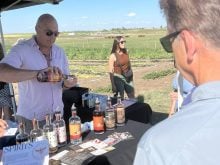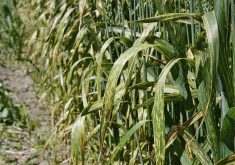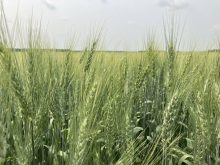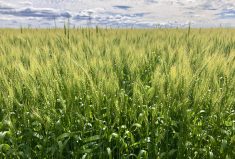Hybrid wheat is finally being commercialized in the Unites States and it could be a long time before that happens in Canada.
But that may not be a big deal, at least in the short term.
Syngenta, which began working on hybrid wheat in 2010, will supply enough seed to plant 5,000 to 7,000 acres this year.
Read Also

Moo translator and methane measures: There’s an app for that
Dalhousie University researchers use artificial intelligence to create new dairy farm apps that analyze cattle sounds and measure methane.
“From the point of view of how much wheat is grown, (the) 5,000 to 7,000 acres being grown from hybrid wheat right now is a very small portion of that,” said Harwinder Sidhu, a winter wheat breeder at Agriculture and Agri-Food Canada’s Lethbridge station.
While hybrid wheat could – in theory – substantially boost yields, it’s an expensive and tricky crop to grow. Three independent seed companies that grew hybrid wheat for Syngenta in 2022 told the Reuters news agency that they were unsure the crop will deliver game-changing results and it will take time to figure out ways to cost effectively produce the best seeds.
Breeding hybrid wheat is complex, said Sidhu.
“Hybrid wheat is basically a cross of two elite parent lines, which results in a progeny which has traits from both the parents and ends up having hybrid vigour, which leads to a potential yield increase of about eight to 15 per cent,” he said.
That’s largely because hybrid vigour improves a plant’s resistance to disease and pests but hybrid wheat has also been shown to do well under drought or heat stress.
However, wheat is a self-pollinating plant and that’s where the challenge lies.
“When you want to produce hybrid seed, you have to break the process,” said Sidhu.
Sterilization of the male components of one of the two parents (to prevent self-fertilization) can be done via genetics or a chemical hybridizing agent that stops pollen production.
“Achieving male sterility is hard,” he said. “All these processes are costly. They rely on excellent timing and sometimes they can’t be 100 per cent effective.”
Hybridization of corn has been called one of the greatest-ever advances in agriculture, with American growers routinely harvesting seven or more times the amount of corn per acre compared to 90 years ago.
But you can’t compare hybrid wheat to hybrids such as corn or canola, said Sidhu.
“The genetics of wheat are very different than corn and canola. Wheat is a hexaploid. With every chromosome, there are six copies (instead of two). When you are making hybrids, it becomes tricky. In a diploid (like corn), it’s easier. You can get a copy from each parent.
“But with a hexaploid, although three copies come from each parent, the genetic effects become so difficult that sometimes it’s hard to manage hybrid wheat production.”
In other words, creating hybrid wheat takes more effort and more management.
“It is probably very costly to produce hybrid seed. That’s the biggest challenge in wheat,” said Sidhu.
It’s also tricky to grow.
Conditions need to be just right for fertilization of the female plants by the male ones to occur, Minnesota seed grower Kevin Capistran told Reuters.
“You just need the right, light wind – not too much, not too little – for that pollen to waft across right at the time when the female plant is opened up ready to receive it,” said the co-owner of Capistran Seed Company, which produced some of Syngenta’s hybrid wheat seeds.
Another grower said he was unsure whether the extra yield would cover the additional expense.
“When we look at the yield advantage of hybrid wheat, it needs to offset that initial seed cost to be really advantageous for growers,” noted Sidhu.
It is not known when hybrid wheat might arrive in Canada, and once it does, it will have to undergo the extensive evaluation and trials needed for registration here.
BASF has a hybrid wheat breeding program at its Pike Lake research facility near Saskatoon and on its website says it “plans to bring hybrid wheat seed to the commercial market in Canada by the mid-2020s.”
In 2021, BASF announced a name for its hybrid wheat variety and promised it would be a major advance.
“With Ideltis, we are unlocking the full potential of wheat,” said Vincent Gros, then president of BASF Agricultural Solutions. “Through our global research platform, we anticipate providing growers, and the entire value chain, hybrid wheat that is tailored to their local needs and consistently delivers better, more stable yield.”
Although hybrid wheat has been a long time coming (the first efforts date back to the 1970s), its introduction in the U.S. bears watching, said Sidhu.
“Growers should always pay attention to what else is out there and what else could help them lower their production costs and increase their profits,” he said. “I think they know better than anyone how to do that.”




